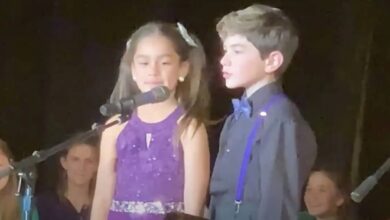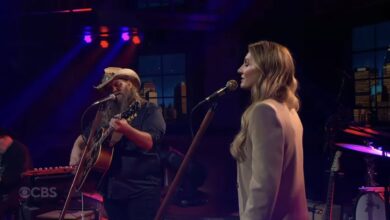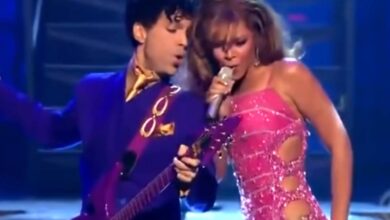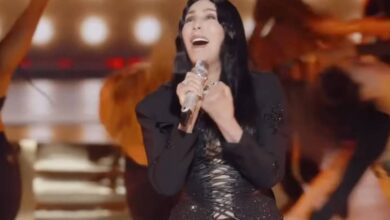Listen : No other Christmas song will ever top this one—it’s the ultimate.
“Fairytale of New York” by The Pogues, featuring Kirsty MacColl, is celebrated as a quintessential Christmas anthem that defies typical holiday song conventions. Released in 1987, this song narrates a raw, emotional story of love, regret, and broken dreams, set against the backdrop of New York City at Christmas. Its unique blend of Irish folk music and gritty lyrics captures the complexity of the season, balancing between melancholy and celebration. This is not your traditional cheerful holiday song but instead paints a realistic, sometimes dark picture of human experiences during the festive period. The song’s stark honesty and authenticity have endeared it to audiences worldwide, earning it a unique place in Christmas music.
From the outset, “Fairytale of New York” captures listeners with its haunting piano introduction, immediately setting a reflective and poignant mood. Shane MacGowan’s gravelly voice emerges, delivering lines that sound like a drunken confession. The story is told through the eyes of a down-and-out character reminiscing about lost dreams and a complicated romance. The narrative unfolds as a conversation between MacGowan and MacColl, who trades lines filled with longing, bitterness, and fleeting hope. Their vocal contrast — his gruff delivery and her smooth, almost angelic voice — enhances the song’s dynamic, creating an intense emotional experience that few Christmas songs achieve.
The song’s lyrics, written by Jem Finer and Shane MacGowan, offer a powerful storytelling approach that resonates on multiple levels. Rather than idealizing Christmas, they acknowledge the struggles people often face, such as financial hardships, failed relationships, and dashed hopes. This perspective is refreshingly honest and relatable, bringing a touch of realism to a genre often dominated by idealized cheer. Lines like “I could have been someone” and the reply “Well, so could anyone” convey the universal theme of disappointment, making the song not just a Christmas anthem but a piece of art that speaks to the human condition.
One of the most intriguing aspects of “Fairytale of New York” is its sense of place. The title itself suggests a fairy tale, yet the story within is anything but a traditional happily-ever-after. New York City, with its vastness and harsh winters, becomes almost another character in the song. The city’s promise of opportunity clashes with the harsh reality of life for the protagonists. It is a place where dreams are supposed to come true, but for these two characters, it represents missed chances and struggles. The setting of New York is both romantic and gritty, perfectly mirroring the bittersweet story.
Watch the video below :
Musically, “Fairytale of New York” is an exceptional blend of traditional Irish folk and punk rock sensibilities. The Pogues’ use of instruments such as the accordion, banjo, and mandolin gives it a distinctive Celtic sound, adding to the song’s authenticity and emotional pull. The arrangement is both uplifting and somber, creating a juxtaposition that amplifies the narrative’s themes. The music crescendos as the song reaches its climax, where the protagonists’ anger and frustration explode before softening into a resigned acceptance. This emotional arc in the music is as compelling as the lyrics, pulling listeners into the characters’ journey.
Kirsty MacColl’s role in the song elevates it to iconic status. Her vocals bring a strength and vulnerability that contrast sharply with MacGowan’s rough voice. MacColl’s character isn’t just a passive partner but a forceful personality who calls out her partner’s failures, bringing a realism to the relationship portrayed. Their exchanges feel genuine, reflecting the ups and downs of real-life relationships. MacColl’s contributions give the song an additional layer of depth, making the duet one of the most memorable aspects of “Fairytale of New York.”
The cultural impact of “Fairytale of New York” extends beyond the holiday season. While it plays every year during Christmas, its themes resonate at any time. Over the decades, it has become a symbol of the less-commercial side of Christmas, reflecting the difficulties that often accompany the season. It’s a reminder that not everyone finds joy during the holidays, and that sometimes, the season can be a time of reflection on what has been lost or what might have been. This authenticity has allowed the song to endure, attracting generations of listeners.
Despite its acclaim, “Fairytale of New York” has also stirred controversy due to some of its language, which reflects the rawness of the characters’ emotions. Some have debated whether certain lines should be censored, arguing that they can be offensive. However, many fans and critics believe the lyrics are essential to maintaining the song’s honesty. The language is true to the characters, highlighting their flaws and desperation. This debate has only fueled the song’s cultural relevance, as it continues to be discussed, dissected, and appreciated for its boldness.
The song’s popularity has led to countless covers and renditions, though none have captured the same raw magic as the original. Artists from different genres have attempted to interpret the song, but the unique chemistry between MacGowan and MacColl, along with the gritty storytelling, remains unmatched. Each cover attempts to bring something new, yet the original’s spirit and poignancy are hard to replicate. This challenge highlights how special the song is, standing as a singular work in holiday music.
In recent years, “Fairytale of New York” has also become a nostalgic reminder of a different era in music. It harks back to a time when artists took risks with their lyrics and explored complex emotions, even in Christmas songs. This risk-taking approach feels refreshing in today’s often-polished music industry. The song’s enduring popularity suggests that audiences still crave authenticity and complexity, even — or perhaps especially — during the holiday season.
Ultimately, “Fairytale of New York” is not just a Christmas song but a profound reflection on life, love, and resilience. Its ability to evoke deep emotions, combined with its unforgettable melody and poignant lyrics, has solidified its place as a holiday classic unlike any other. For many, it encapsulates the true spirit of Christmas: a blend of joy, sorrow, love, and loss. This complexity, coupled with its timeless appeal, is why it remains unmatched as a Christmas anthem.





